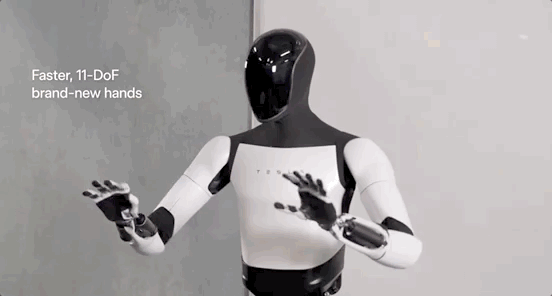Tesla has revealed some of its humanoid robot technology through filings for several new patents related to its Optimus robot program.
A few months ago, Tesla unveiled “Optimus Gen 2”, a new generation of its humanoid robot that should be able to take over repetitive tasks from humans.
The new prototype showed a lot of improvements compared to previously underwhelming versions of the robot, and it gave some credibility to the project.
One of the main changes with the Optimus Gen 2 is the fact that Tesla is now using all its own inhouse-designed custom actuators to power the robot’s limbs.
Now, Tesla has filed several patents related to the technology behind its humanoird robot.
In the first patent, Tesla describes its ‘actuator and actuator design methodology’:
A system or methodology of controlling movement of a robot (600) using actuators, the system can include one or more first type of actuators (1002) positioned at torso, shoulder, and hip locations of the robot; one or more second type of actuators (1004) positioned at wrist locations of the robot; one or more third type of actuators (1006) positioned at the wrist locations of the robot; one or more fourth type of actuators (1008) positioned at elbow and ankle locations of the robot; one or more fifth type of actuators (1010) positioned at the torso location and the hip locations of the robot; and one or more sixth type of actuators (1012) positioned at knee locations and the hip locations of the robot.
Here are some of the drawings from the patent application:


Interestingly, the first gen Optimus is featured in those drawings for the first patent application.
The other patent applications feature images of the new Optimus.
The next patent is called ‘Sytems and methods for a robot knee joint assembly’ and as the name suggest, it is specifically about the bot’s knee.
Tesla described the technology in its patent application:
Disclosed herein is a knee joint assembly including a first link member having a first end mechanically coupled to an upper leg of a robot and configured to rotate around a first pivot relative to the upper leg, and a second link member having a first end mechanically coupled to a lower leg of the robot. The lower leg can be mechanically coupled to the upper leg and configured to rotate around a second pivot relative to the upper leg. A linear actuator device can be mechanically coupled to a second end of the first link member and a second end of the second link member, and when actuated can cause the first link member to rotate around the first pivot relative to the upper leg of the robot and cause the leg to rotate around the second pivot relative to the upper leg.
Here are some of the drawings from the patent application:


The last patent application that we found is particularly interesting as it relates specifically to the Tesla Optimus hands.
The patent application is called ‘Underactuated hand with cable-driven fingers’.
Tesla wrote in the patent application:
A robotic hand system can comprise a palm region and one or more fingers, each finger comprising an actuator device; a proximal member having a first end mechanically coupled to the palm region robot and configured to rotate around a first pivot relative to the palm region; a distal member having a first end mechanically coupled to a second end of the proximal member and configured to rotate around a second pivot relative to the proximal member; and a cable having a first portion coupled to the actuator and a second portion extending along the proximal member and the distal member, the second portion separated away from the first pivot and the second pivot and having an end with a higher dimension than a diameter of the cable, the end with higher dimension structured to engage the distal member when the cable is pulled by the actuator.
Here are some of the drawings from the patent application:



In the latest sneak peek at the latest robot prototypes that Tesla showed, we could see much improved hand dexterity.

There’s no clear timeline for Tesla to bring the robot to production, but Tesla CEO Elon Musk said in 2022 that it could go into production as soon as 2023 – though that didn’t happen.
Musk recently said that the robot would cost about half of a car.
FTC: We use income earning auto affiliate links. More.



